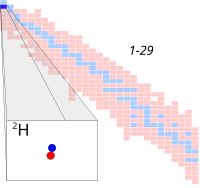
Photo from wikipedia
Surface nuclear magnetic resonance (NMR) is a unique technique to study groundwater, as it provides direct insights into water content and pore-scale properties. However, surface NMR suffers from an extremely… Click to show full abstract
Surface nuclear magnetic resonance (NMR) is a unique technique to study groundwater, as it provides direct insights into water content and pore-scale properties. However, surface NMR suffers from an extremely weak signal that limits mapping speeds and can prohibit measurements in high ambient noise environments. It has recently been demonstrated that steady-state sequences can deliver orders of magnitude signal-to-noise ratio (S/N) enhancement in comparison with standard methods. Most notably, the steady-state approach collapses the surface NMR signal into an extremely narrow frequency band, which leads to vastly improved noise rejection. In this article, we develop the signal processing chain for steady-state surface NMR data. Each step in the signal processing chain, transient culling, pulse windowing, de-spiking, powerline harmonics subtraction, and spectral analysis are explained in detail. We demonstrate how error estimation can be efficiently performed using the power spectral density in the vicinity of the transmitting frequency. We also demonstrate how off-resonance excitation can be determined by locating the peak spectrum of surface NMR signal with an array of phase-corrected discrete Fourier transforms (DFTs). The presented signal processing methods can be easily implemented and applied to extract signal features for quality control and inversion procedures. We give a field example where data collected with steady-state pulse sequences are processed and inverted.
Journal Title: IEEE Transactions on Instrumentation and Measurement
Year Published: 2023
Link to full text (if available)
Share on Social Media: Sign Up to like & get
recommendations!